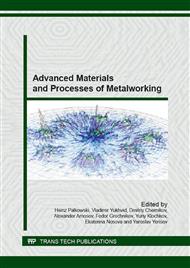[1]
K.U. Kainer, (Ed. ), Metal Matrix Composites: Custom-made Materials for Automotive and Aerospace Engineering, WILEY-VCH Verlag GmbH & Co. KGaA, Weinheim, (2006).
DOI: 10.1080/10426910701884301
Google Scholar
[2]
A.A. Adebisi, М.А. Maleque, М. М Rahman, Metal matrix composite brake rotor: historical development and product life cycle analysis, Int. J. of Auto. and Mech. Eng. 4 (2011) 471-480.
DOI: 10.15282/ijame.4.2011.8.0038
Google Scholar
[3]
D.R. Clarke, Interpenetrating phase composites, J. Am. Ceram. Soc., 75 (1992) 739–758.
Google Scholar
[4]
H.X. Peng, Z. Fan, J.R.G. Evans, Bi-continuous metal matrix composites, Mater. Sci. Eng. A., 303 (2001) 37-45.
Google Scholar
[5]
J. Liu, J. Binner, R. Higginson, Dry sliding wear behavior of co-continuous ceramic foam/aluminum alloy interpenetrating composites produced by pressureless infiltration, Wear, 276-277 (2012) 94-104.
DOI: 10.1016/j.wear.2011.12.008
Google Scholar
[6]
J. Binner, H. Chang, R. Higginson, Processing of ceramic-metal interpenetrating composites, J. Eur. Ceram. Soc., 29 (2009) 837-842.
DOI: 10.1016/j.jeurceramsoc.2008.07.034
Google Scholar
[7]
A.N. Pityulin, Yu.V. Bogatov, A.S. Rogachev, Gradient hard alloys, Int. J. of Self-Prop. High-Temp. Synth. 1 (1992) 111-118.
Google Scholar
[8]
A. F. Fedotov, A. P. Amosov, E. I. Latukhin, A.A. Ermoshkin, D.M. Davydov, Effect of gasifying additives on the phase composition of combustion products when self-propagating high-temperature synthesis of MAX-phases in the Ti-C-Al system, Izvestiya Samarskogo Nauchnogo Tsentra RAN, 16 (2014).
Google Scholar
[9]
A.P. Amosov, I.P. Borovinskaya, A.G. Merzhanov, Powder Metallurgy of Self-propagating High-temperature Synthesis of Materials, Mashinostroenie-1, Moscow, 2007. (In Russian).
Google Scholar
[10]
A. F. Fedotov, A. P. Amosov, V. P. Radchenko, Modeling of the Compaction Process of Powder Materials in Terms of Self-propagating High-temperature Synthesis, Mashinostroenie-1, Moscow, 2005. (In Russian).
Google Scholar
[11]
Industrial Aluminum Alloys, Guide, Metallurgiya, Moscow, 1984. (In Russian).
Google Scholar


